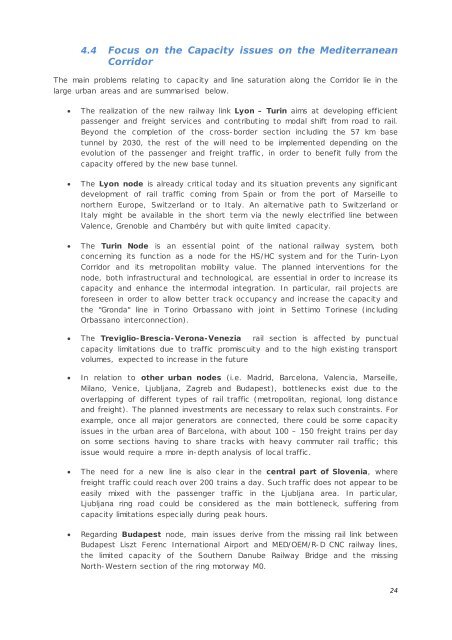Mediterranean
5Lwz6ndOG
5Lwz6ndOG
Create successful ePaper yourself
Turn your PDF publications into a flip-book with our unique Google optimized e-Paper software.
4.4 Focus on the Capacity issues on the <strong>Mediterranean</strong><br />
Corridor<br />
The main problems relating to capacity and line saturation along the Corridor lie in the<br />
large urban areas and are summarised below.<br />
• The realization of the new railway link Lyon – Turin aims at developing efficient<br />
passenger and freight services and contributing to modal shift from road to rail.<br />
Beyond the completion of the cross-border section including the 57 km base<br />
tunnel by 2030, the rest of the will need to be implemented depending on the<br />
evolution of the passenger and freight traffic, in order to benefit fully from the<br />
capacity offered by the new base tunnel.<br />
• The Lyon node is already critical today and its situation prevents any significant<br />
development of rail traffic coming from Spain or from the port of Marseille to<br />
northern Europe, Switzerland or to Italy. An alternative path to Switzerland or<br />
Italy might be available in the short term via the newly electrified line between<br />
Valence, Grenoble and Chambéry but with quite limited capacity.<br />
• The Turin Node is an essential point of the national railway system, both<br />
concerning its function as a node for the HS/HC system and for the Turin-Lyon<br />
Corridor and its metropolitan mobility value. The planned interventions for the<br />
node, both infrastructural and technological, are essential in order to increase its<br />
capacity and enhance the intermodal integration. In particular, rail projects are<br />
foreseen in order to allow better track occupancy and increase the capacity and<br />
the "Gronda" line in Torino Orbassano with joint in Settimo Torinese (including<br />
Orbassano interconnection).<br />
• The Treviglio-Brescia-Verona-Venezia rail section is affected by punctual<br />
capacity limitations due to traffic promiscuity and to the high existing transport<br />
volumes, expected to increase in the future<br />
• In relation to other urban nodes (i.e. Madrid, Barcelona, Valencia, Marseille,<br />
Milano, Venice, Ljubljana, Zagreb and Budapest), bottlenecks exist due to the<br />
overlapping of different types of rail traffic (metropolitan, regional, long distance<br />
and freight). The planned investments are necessary to relax such constraints. For<br />
example, once all major generators are connected, there could be some capacity<br />
issues in the urban area of Barcelona, with about 100 – 150 freight trains per day<br />
on some sections having to share tracks with heavy commuter rail traffic; this<br />
issue would require a more in-depth analysis of local traffic.<br />
• The need for a new line is also clear in the central part of Slovenia, where<br />
freight traffic could reach over 200 trains a day. Such traffic does not appear to be<br />
easily mixed with the passenger traffic in the Ljubljana area. In particular,<br />
Ljubljana ring road could be considered as the main bottleneck, suffering from<br />
capacity limitations especially during peak hours.<br />
• Regarding Budapest node, main issues derive from the missing rail link between<br />
Budapest Liszt Ferenc International Airport and MED/OEM/R-D CNC railway lines,<br />
the limited capacity of the Southern Danube Railway Bridge and the missing<br />
North-Western section of the ring motorway M0.<br />
24



